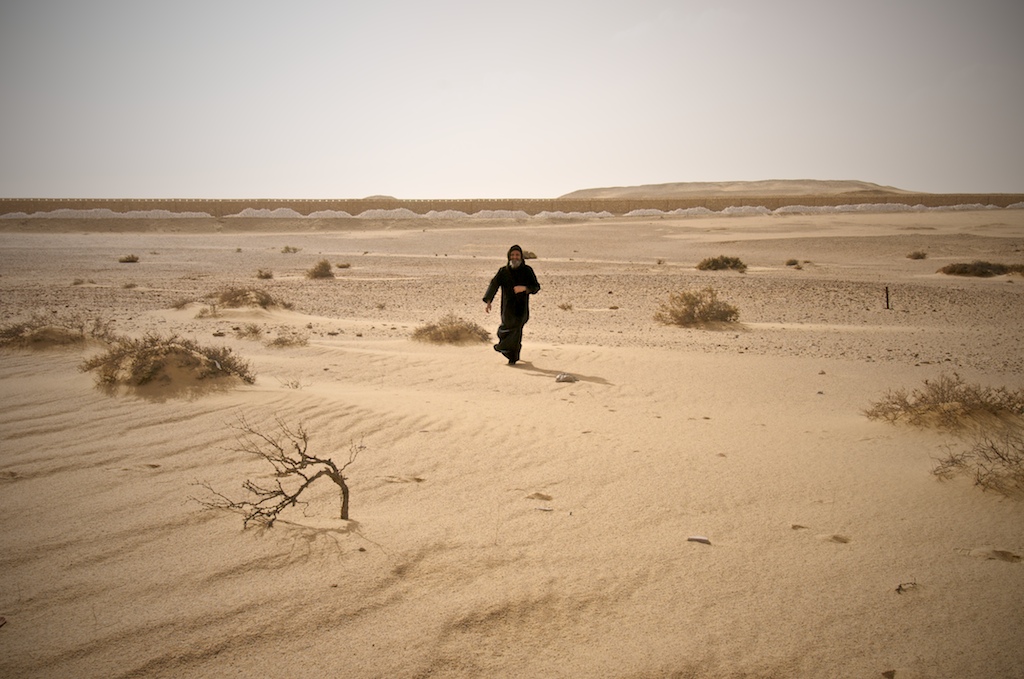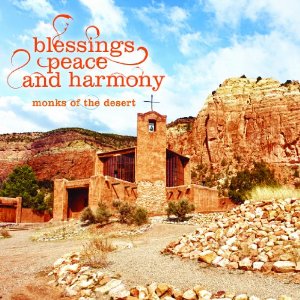‘…unlike metaphorical deserts, real deserts look after their own. There are fewer survival skills needed for life in a real desert. The metaphorical interior and exterior deserts are far deadlier.’Embracing the Desert
‘The Desert isn't just a geographical location that receives very little rainfall. It is also a metaphorical location where temptations, trials, and spiritual battles take place.’
By a Monk of the Monastery of Christ in the Desert
One term that has come to me regarding my own vocation is to "Embrace the Desert.” It is a phrase that came to me once, several months ago. I am not sure entirely what it means. It is something that I have to start struggling with defining.
So, let's start with "The Desert.” It would appear that there are two kinds of deserts: interior deserts and exterior deserts. There are metaphorical deserts as well, but they overlap with both interior and exterior deserts. Consequently, I cannot really call them a separate category.
Once, a good 20 years ago now, I described myself as a desiccated planet full of dead cities filled with rotting corpses. I realize that that is not exactly a positive image. So much for Positive Confession, right? Over the last 20 years or so the rains have returned and a new, greater internal civilization has replaced the old. There are still, however, vast internal metaphorical deserts.
These would be the internal deserts of sin, abandonment, loneliness, and twisted love of which Pope Benedict spoke in his inaugural sermon. These can be the scariest kinds of deserts to embrace.
The next most terrifying are the deserts caused by human interactions. In thinking of this, I thought of the Eurythmics tune "Sweet Dreams.” Part of the lyrics say: "Some of them want to use you/Some of them want to get used by you/Some of them want to abuse you/Some of them want to be abused.” How many deserts of human interaction are described right there? BDSM. Recreational use of sex, drugs and each other. These are external metaphorical deserts so large in scope and severity that they make the Sahara look like a sandbox and the Atacama look like a rain forest.
Eurythmics, ‘Sweet Dreams’: Describing deserts of human interaction…Real, physical deserts can be inhospitable and forbidding. This natural inhospitality may be why desert cultures value hospitality so highly. Their lives may literally depend on it. But, unlike metaphorical deserts, real deserts look after their own. There are fewer survival skills needed for life in a real desert. The metaphorical interior and exterior deserts are far deadlier.
The first image of Christ in the Desert that has really stayed with me was a week or so into my first stay, in October 2003. The leaves had fallen from the trees. It was a clear night, with a Full Moon over the canyon. I was sleepless so I headed outside. And into a view so beautiful it hurt. The moonlight made everything look black and white. Everything was etched in stark relief. The cliffs of the canyon seemed that much more high, that much more strong, that much more solid. The only sound was the occasional breeze being sifted through the trees. It is that image of starkness that has stayed with me to this day, even though in summer the canyon is very green and teems with life.
That is the easy part of the question. The Desert isn't just a geographical location that receives very little rainfall. It is also a metaphorical location where temptations, trials, and spiritual battles take place. These temptations, trials, and battles need not take place in physical deserts. They can also take place in the context of one's interior life or one's exterior relations with others.
It is by means of those battles, trials, and temptations that we "embrace the desert.” It is both a place of testing and a place of supplication; a crucible and a ciborium.
Audio clip: Gloria IX (Mode: VIII – Mixoylydian). From Blessings, Peace and Harmony
The deserts of Egypt and Asia Minor were among the places where monasticism had its beginnings in the first place. For example, St. Antony of Egypt and St. Basil of (I think) Cappadocia, were early ascetics associated with early monasticism. So by Embracing the Desert, I am embracing the monastic and ascetic life in the first place.
That is not all that "Embracing the Desert" means. More than one Vocations Director has told me that the hardest part of monastic life is the fact that you live and work with the same people 24X7. They have a point.
On the "outside,” it is easy to avoid Mr. Needsacluebyfour. If it is online, then the irritant can be placed on ignore. Problem "solved"; irritant removed. But spiritual growth does not take place. But, it is much different once you are in the "desert" of the monastic enclosure. In a large community with multiple apostolates, you can put off dealing with Br. Needsacluebyfour, but you still have to deal with him eventually. In a cloistered contemplative community, there is no getting away from Br. Needsacluebyfour. One thing to keep in mind that your Br. Sanctimonioustwit might think you are his Br. Slackingloser. And I need to have the humility to admit the possibility that I might be the one who is in need of the clue by four. You have to face the problem, and the problem has to face you.
Dear Abbot: How can I incorporate meditation in daily life? Abbot Philip Lawrence OSB answers.A cloistered monk and his community do not exist in isolation. It is not a simple withdrawal from the world. It is a withdrawal from the world in order to more fully engage it in a detached fashion. By means of this detachment, it is easier to see more clearly the trials, traps, and temptations that lie in the external deserts of interpersonal relations. This is another way in which I can "embrace the desert,” through intercessory prayer. A monk who is not cloistered can also "embrace the desert" through their external apostolates. Neither the cloistered nor the non-cloistered monastic community exists in isolation. The only distinction is the means through which the "desert" can be "embraced.”
I think that easily the harshest type of desert I am called to embrace is the desert within. There is where the true battleground is. Withdrawing into a physical desert or some other wilderness can help cut down on distractions. That will give the fight more clarity.
Because when you are alone with God you are also alone with yourself. If you have freed yourself from distractions, then you are faced with the naked fury of your own interior desert. Abandonment. Sin. The Flesh. The things you did that you ought not to have done, and the things you left undone that you ought to have done. If you cannot embrace that desert when you are faced with it, there will be no help for you.
So, "Embrace the Desert" means to embrace all aspects of the monastic vocation, with all of its struggles and all of its trials.
***
Support the Benedictine Abbey of Christ in the Desert
A statement by Abbott Philip Lawrence:
In keeping with the Rule of Saint Benedict, we balance our life of prayer, study and hospitality with work for our daily bread. Each monastery is expected to be self-supporting. We do not receive financial underwriting from our archdiocese, nor other institutions of the Church, including the Vatican. Over all of the years that I have been at Christ in the Desert, the Lord has provided for us and has never failed us. While God never gives us everything that we want, we really have never lacked what is necessary for our monastic life.We have always insisted that prayer can never be reduced for the sake of work. In our modern world there is a continual pressure to shorten the quiet times of prayer so that we can get more work done. However, we have never seen that as required. Always the friends and benefactors of our community have made our life possible through their prayerful presence, participation and partnership with us.
In a few years, on June 24, 2014, Christ in the Desert will celebrate 50 years since its foundation in 1964. I will turn 70 years old the following day. Those anniversaries form a clear goal for me to aim at. I would love to have all of the earlier construction debt paid off, our physical plant completed and paid for, the foundations independent, and an endowment in place for our future to support a strong and stable community at Christ in the Desert.
The Abbey's most urgent needs at present:
*Help pay the propane bill: We spend about $6,600 per month on the propane that supplements our solar power grid. Until we raise the funds to needed to upgrade our power grid, our propane expenses are a concern for us.
*Complete the fund to upgrade our water system, which is mandated by the state: Though our system is safe, it is inadequate for our current demands. We need to raise about $100,000 more.
At "Supporting Us" on the monastery's website, the full range of the monastery's needs are listed along with various levels of suggested support ranging from $25 on up, along with the complete text of Abbot Philip's statement titled "Financial Reflections from Our Abbot Philip."
Founder/Publisher/Editor: David McGee
Contributing Editors: Billy Altman, Laura Fissinger, Christopher Hill, Derk Richardson
Logo Design: John Mendelsohn (www.johnmendelsohn.com)
Website Design: Kieran McGee (www.kieranmcgee.com)
Staff Photographers: Audrey Harrod (Louisville, KY; www.flickr.com/audreyharrod), Alicia Zappier (New York)
E-mail: thebluegrassspecial@gmail.com
Mailing Address: David McGee, 201 W. 85 St.—5B, New York, NY 10024




